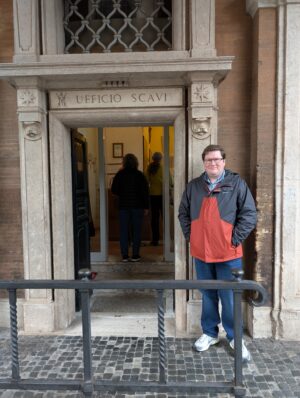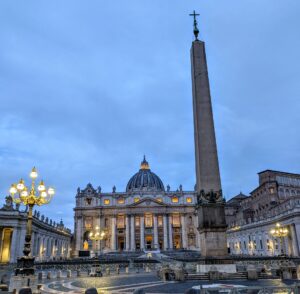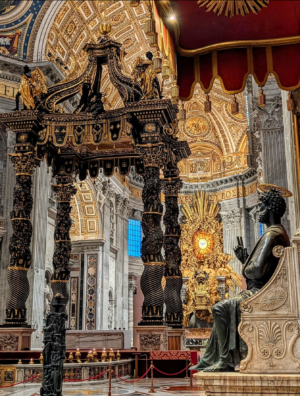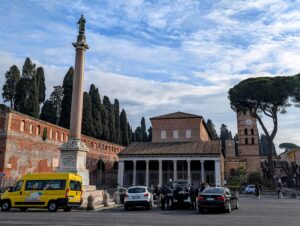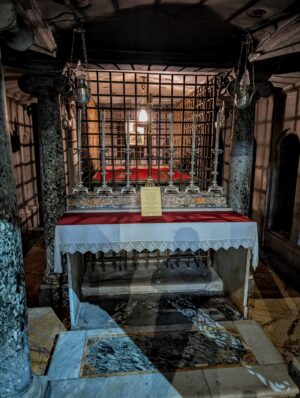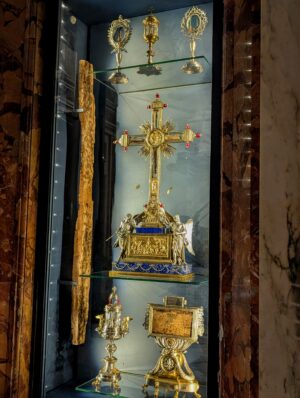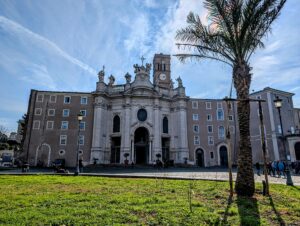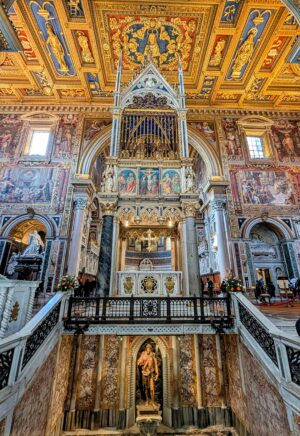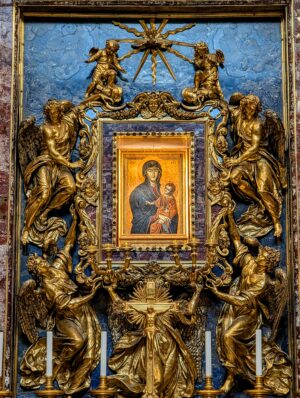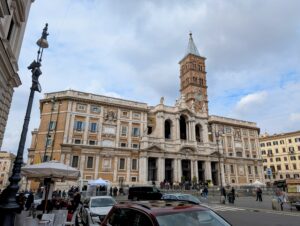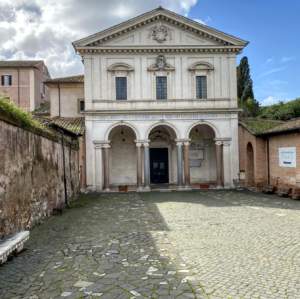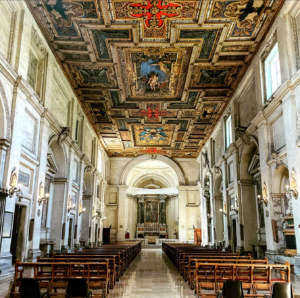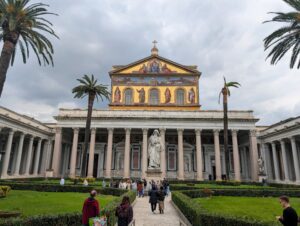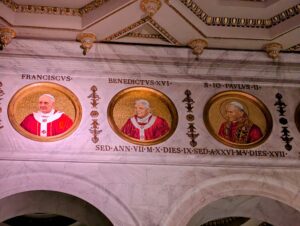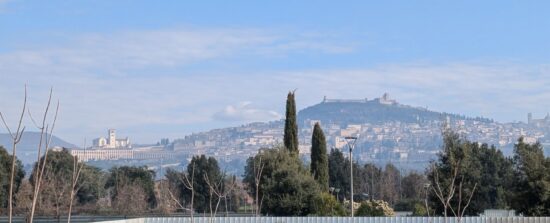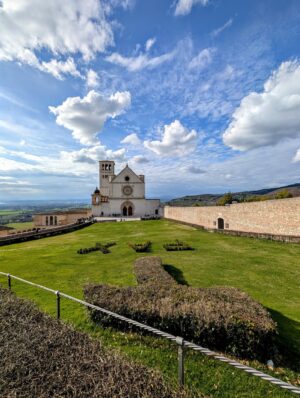Back in February, I had the privilege of journeying to Rome for the Jubilee. In his Bull of Indiction of the Ordinary Jubilee of the Year 2025, Pope Francis wrote, "For everyone, may the Jubilee be a moment of genuine, personal encounter with the Lord Jesus, the "door" of our salvation, whom the Church is charged to proclaim always, everywhere and to all as "our hope". In this blog, I wanted to share some of my experiences.
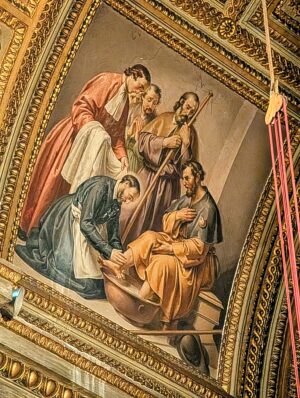
Painting of Saint Philip Neri washing the feet of the pilgrim. The man in red is a member of the Archconfraternity
On the first night that I arrived in Rome, I made my way over to the Church of the Most Holy Trinity of Pilgrims. The church was founded in 1540 by Saint Philip Neri, future founder of the Congregation of the Oratory. Together with a few followers, the Confraternity of the Most Holy Trinity of Pilgrims and Convalescents. In years of Jubilee, the group would care and house many pilgrims coming to Rome. Though not housing pilgrims anymore, they continue one tradition going back to the time of Saint Philip Neri. After evening Mass and induction of new members, pilgrims can participate in a rite where their feet are washed before embarking on the Seven Church Pilgrimage.
The next day was a special one, as we visited the Vatican Necropolis. Underneath Saint Peter’s Basilica is a Roman burial ground called a necropolis, which translates to “city of the dead” in Greek. Unlike a modern-day cemetery, these tombs are above ground and along a narrow road called Via Cornelia. The origins of this sacred site can be traced back to the 1st century AD when Saint Peter, one of Jesus Christ's apostles and considered the first pope, was martyred in Rome. The location of his burial became a place of veneration for early Christians. During the construction of the first St. Peter's Basilica in the 4th century, an extensive necropolis was discovered beneath the site. This underground burial ground was subsequently integrated into the foundations of the new basilica. It was amazing to see the different layers from the Roman road up until today. The beginning of the tour focused on ancient Roman tombs, each one more impressive than the previous. At the end of the long hallway of monuments was the only Christian tomb in the necropolis, decorated with images from Bible verses like Jonah and the whale. On the ceiling is an early image of Christ on a chariot drawn by white horses. Before exiting into the Vatican grottos, our guide showed us where the bones of Saint Peter rest. Our guide gave us time for private prayer before leaving.
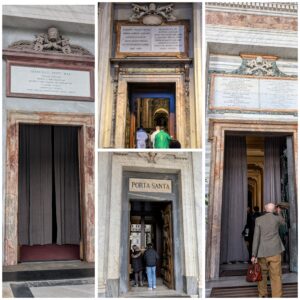
The four Holy Doors opened L to R: Saint Paul Outside the Walls, Saint Peter's, Saint Mary Major, and Saint John Lateran
As mentioned in a previous blog, one of the main facets of a Jubilee year is the passing through the Holy Doors. Originally, there was only one Holy Door, located at Saint Peter’s Basilica. As time went on and more people were making pilgrimage to Rome, other Basilicas opened their own Holy Doors. The other three, which are Papal Basilicas, are Saint Mary Major, Saint John Lateran, and Saint Paul Outside the Walls. These doors are only opened during years of Jubilee, which are normally every 25 years. For more on the importance on Jubilee, see our previous blog: https://chrc-phila.org/jubilee/
The busiest day of my pilgrimage was visiting the Seven Pilgrim Churches of Rome, a tradition going back to Saint Philip Neri. It started around 1553 in order to combine conviviality and the sharing of a common religious experience through discovering of the heritage of the early Saints. At each church, there would be prayer, hymn singing and a brief sermon by Neri. In addition to the four Papal Basilicas mentioned above, there are three minor Basilicas. The day began with Holy Mass at Saint Peter’s Basilica, specifically at the Altar of Saint Joseph. Despite Mass being in Italian, I was able to follow along as the flow is the same. Saint Peter’s Basilica is the largest Church in the world, and is built over the tomb of Saint Peter. The current Basilica was built in the 1600s to replace the earlier Basilica from the time of Emperor Constantine. At the end of the Basilica, beyond the canopy (baldachin) is the Altar of the Chair of Saint Peter. Designed by sculptor Gian Lorenzo Bernini, it contains the relic of a wooden throne that tradition claims belonged to the Apostle Saint Peter, the leader of the Early Christians in Rome and first Pope, and which he used as Bishop of Rome. Lining the nave of the Basilica are statues of the founders of several religious orders, some of which are presently in our Archdiocese (Redemptorists, Christian Brothers, etc.).
Our next stop was the Basilica of Saint Lawrence Outside the Walls, housing the relics of Saints Lawrence and Stephen, both martyred deacons of the early Church. Saint Lawrence was the archdeacon of Rome in the mid 200s who, under the persecutions of the Emperor Valerian, was tasked with protecting the treasures of the Church. After Pope Sixtus II was persecuted and before his eventual martyrdom, the Roman government demanded that Lawrence turn over the riches of the Church, so Lawrence asked for three days to gather the wealth. He worked swiftly to distribute as much Church property to the indigent as possible to prevent it from being seized by the prefect. One such item is the Valencia Chalice, which is said to be the cup that Jesus used at the Last Supper. On the third day, at the head of a small delegation, Lawrence presented himself to the prefect. When ordered to deliver the treasures of the Church, he presented the city's indigent, crippled, blind, and suffering, and declared that these were the true treasures of the Church: "Here are the treasures of the church. You see, the church is truly rich, far richer than your emperor!" For me, stopping here was important since Saint Lawrence is the patron Saint of archivists. The structure was heavily damaged from bombing raids on nearby rail yards during World War II. The reason for the title “Outside the Walls” refers to the fact that the basilica lies outside the original Aurelian Wall of Rome.
The third Church was the Basilica of the Holy Cross in Jerusalem, built in the fourth century at the palace of Saint Helena. Saint Helena was the mother of Emperor Constantine and, according to legend, she traveled to Jerusalem to build churches at holy sites and bring back relics related to Christ's Passion. These relics include thorns from the Crown of Thorns, fragments of the True Cross, and nails from the Crucifixion. Here is also the Titulis Crucis, the sign that was hung on Jesus' cross, reading "Jesus of Nazareth, King of the Jews" in three languages. There is debate over whether this is a medieval forgery, a copy of the original, or the authentic placard. The name in Jerusalem comes from the fact that soil from Jerusalem was brought to cover the floor; thus, those who stood within the basilica were, in a sense, in Jerusalem.
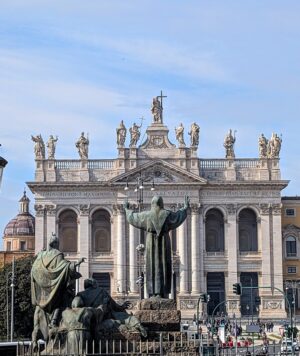
Archbasilica of the Most Holy Savior and Saints John the Baptist and John the Evangelist at the Lateran, Statue of Saint Francis of Assisi and his Companions in the foreground.
A small walk from the basilica, towards Saint John Lateran, was the Pontifical Sanctuary of the Scala Sancta. The Scala Sancta are said to be the twenty-eight steps that were climbed by Jesus while at the palace of Pontius Pilate on Good Friday, brought to Rome by Saint Helena. Encased in marble, pilgrims ascend the stairs on their knees. At the top is the Sancta Sanctorum, the original private chapel of the Popes. The whole building was originally part of the Lateran Palace from the reign of Constantine until the move to Avignon in 1309. When the Papacy returned to Rome in 1377, the Lateran Palace was found in ruin due to misuse and fire. When Pope Sixtus moved the Papal residence to Saint Peter's Basilica, part of the palace was restored and has served many functions over the centuries. Right next door is the Archbasilica of Saint John Lateran, the Mother Church of the Catholic faithful. Like the Scala Sancta, this was all part of the old Papal Palace. The name comes from both the Laterani family that occupied the area and the two Saints its honors: Saint John the Evangelist and Saint John the Baptist. It also serves as the official seat of the Bishop of Rome, the Pope. In front of the Archbasilica is a statue of Saint Francis and his Companions, who traveled to Rome in 1209 to seek the approval of the Pope for his way of life. From the angle of the picture on the left, it seems like Saint Francis is holding up the Church, which was seen in a dream by Pope Innocent III. Housed inside are the relics of the table of the Last Supper and the skulls of Saints Peter and Paul. The nave (center) of the Basilica contains giant statues of eleven Apostles and Saint Paul, each with instruments of their martyrdom. Behind the basilica is the baptistry, which is strange since most baptismal fonts are located within the church. Apparently, it was the first Baptistery to be constructed after freedom of worship was granted to Christians by the Emperor Constantine with promulgation of the Edict of Milan in 313.
A short distance away is the Basilica of Saint Mary Major, the oldest Marian worship site in Western Christianity. According to legend, the Virgin Mary appeared to Pope Liberius and a wealthy man named John Patricius in 352. She told them to build a church on a spot where snow would fall in the middle of summer. This is known as the apparition of Our Lady of the Snows. Under the main altar is the Reliquary of the Holy Crib, which contains wood from the crib from the nativity of Jesus Christ. Nearby are buried Gian Lorenzo Bernini and the relics of Saint Jerome, Doctor of the Church who translated the Bible into the Latin language. The basilica also houses the Salus Populi Romani icon. According to tradition, the icon was painted by Saint Luke the Evangelist. During the pontificate of Pope Francis, the Marian image has gained a significant amount of commentary, as Pope Francis prays before the image when he leaves and returns to Rome.
On the way to the next church, I stopped the Church of Santa Maria in Palmis located on the Appian Way. According to the Acts of Peter, as Saint Peter was fleeing persecution under Emperor Nero, Jesus appeared to him walking in the opposite direction. Peter was excited and asked him "Domine, quo vadis?" ("Lord, where are you going?"), Christ replied that he was going to Rome to be crucified a second time. Walking down the Appian Way, pilgrims will reach the Basilica of Saint Sebastian Outside the Walls, dedicated to the martyred saint. Inside the structure are two interesting objects. The first is a bust of Jesus Christ called "Salvador Mundi," the last work by Gian Lorenzo Bernini. The Right next to the entrance to the basilica are the entrance to the Catacombs, an underground burial complex used by the earliest Christians. There are several catacombs scattered around the city, but all outside the Aurelian Wall. The reason for this is, in Roman times, people could not be buried within the city limits.
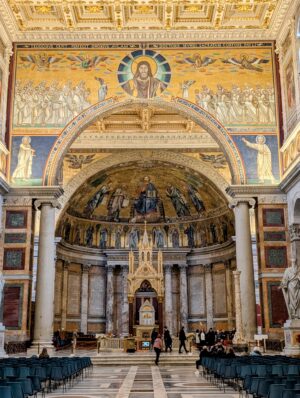
The apse and arch over the main altar, both of which are the only surviving elements of the original structure that burnt down in the 1800s.
The last of the Seven Pilgrim Churches is the Basilica of Saint Paul Outside the Walls, the largest Church in Rome and built over the remains of Saint Paul. At one point, the basilica was larger than Old Saint Peter's, but that changed when Pope Julius II demolished the older structure and built the Basilica that stands today. Bordering the ceiling of the basilica are mosaic portraits of all the Popes, starting with Saint Peter going to Pope Francis. In 1823, an accidental fire almost completely destroyed the entire Basilica. However, due to donations from across the world, Saint Paul's was rebuilt and reopened in 1849.The only remnants from the disaster are the apse and the archway, pictured to the right.
Besides vising the Seven Pilgrim Churches, visiting several Roman sites and enjoying local pasta dishes (one of which I learned to make), I took a day-trip to Assisi. I had always wanted to go to Assisi, which I like to call the most-popular small town in Italy, mainly due to pilgrimages concerning Saint Francis and Saint Clare. It was nice to get away from the hustle-and-bustle of Rome, with large amounts of pilgrims arriving for the Jubilee of Deacons. From the train station 3 miles away, the Basilica of Saint Francis is an imposing force on the landscape. Construction of the basilica began in 1228, two years after the death of Francis and the same year he was canonized a saint. Though pictures are now allowed inside, I can visually remember the frescos on the walls and ceiling, some of which are still there despite their age and survival through natural disaster. They were painted by numerous late medieval painters from the Roman and Tuscan schools like Cimabue, Giotto, and Simone Martini. The rest of the town blends the Old-World charm of the architecture with the modern conveniences of today. With the size and slant of the streets, it is amazing how modern vehicles can fit with ease.
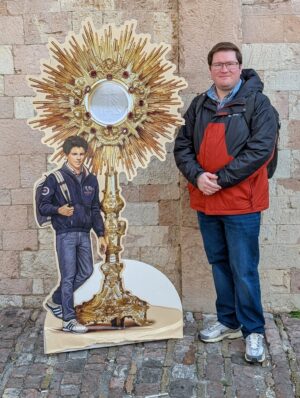 Recently, there has been another draw to the town. In a small, unassuming church called Saint Mary Major lies the remains of Blessed Carlo Acutis. Born in 1991, he was devout from a young age, even asking if he could receive Holy Communion as early as age 6. One of the biggest impacts that is still seen today is his exhibit on Eucharistic miracles. As a teenager in 2004 up until his death in 2006, he created a website that gave details on every Eucharistic miracle and Marian apparition. (https://www.miracolieucaristici.org/en/liste/list.html) Carlo used the Internet, which was more robust that it is today, to evangelize people around the world. I think one of the reasons Carlo is getting a large amount of attention is the fact that his was so young and displayed a profound love for Jesus and the Eucharist. He can also be seen as a role model to young people struggling with faith in the modern world. Later his month, on Divine Mercy Sunday (April 27th), Carlo is set to be canonized, making him the first Millennial Saint. Recently, in 2023 during the Archdiocesan Eucharistic Congress, Carlo's mother Antonia spoke near the end of the day-long event. She remarked how "The most important thing for Carlo was the Eucharist. He used to call the Eucharist 'My Highway to Heaven.' Why? Because we know the Eucharist is the most supernatural thing we have in the world. We have Jesus among us."
Recently, there has been another draw to the town. In a small, unassuming church called Saint Mary Major lies the remains of Blessed Carlo Acutis. Born in 1991, he was devout from a young age, even asking if he could receive Holy Communion as early as age 6. One of the biggest impacts that is still seen today is his exhibit on Eucharistic miracles. As a teenager in 2004 up until his death in 2006, he created a website that gave details on every Eucharistic miracle and Marian apparition. (https://www.miracolieucaristici.org/en/liste/list.html) Carlo used the Internet, which was more robust that it is today, to evangelize people around the world. I think one of the reasons Carlo is getting a large amount of attention is the fact that his was so young and displayed a profound love for Jesus and the Eucharist. He can also be seen as a role model to young people struggling with faith in the modern world. Later his month, on Divine Mercy Sunday (April 27th), Carlo is set to be canonized, making him the first Millennial Saint. Recently, in 2023 during the Archdiocesan Eucharistic Congress, Carlo's mother Antonia spoke near the end of the day-long event. She remarked how "The most important thing for Carlo was the Eucharist. He used to call the Eucharist 'My Highway to Heaven.' Why? Because we know the Eucharist is the most supernatural thing we have in the world. We have Jesus among us."



